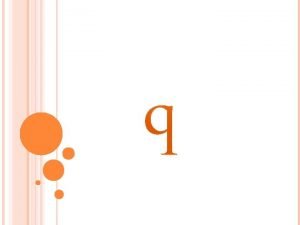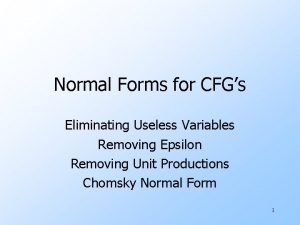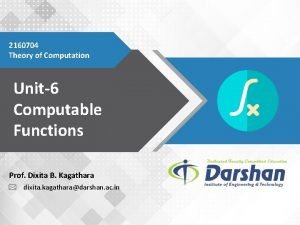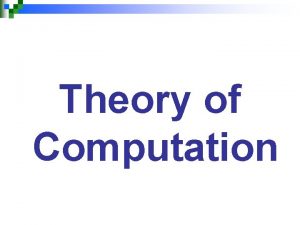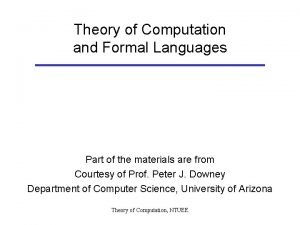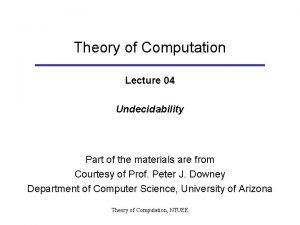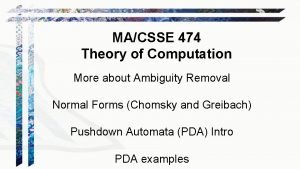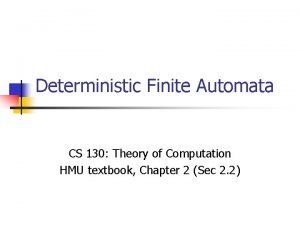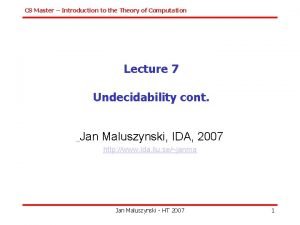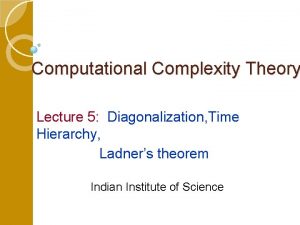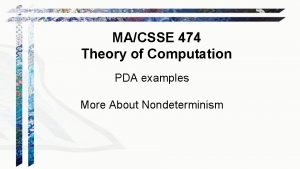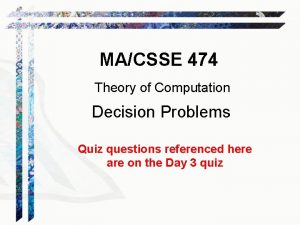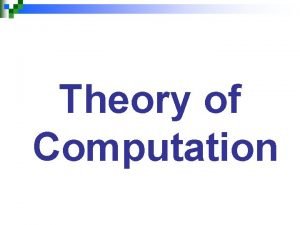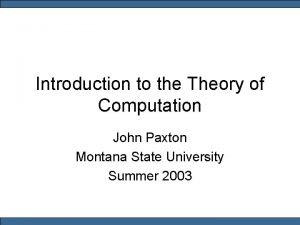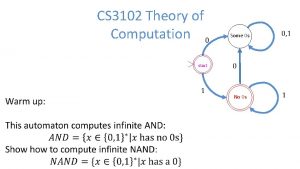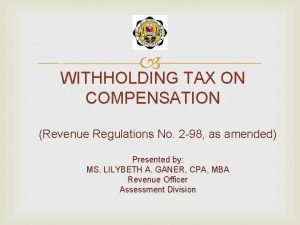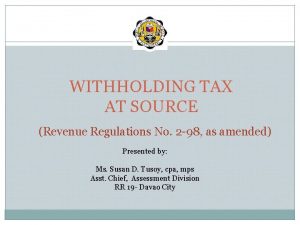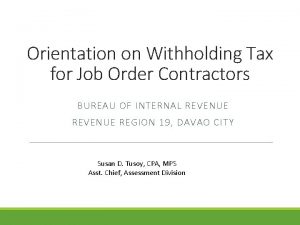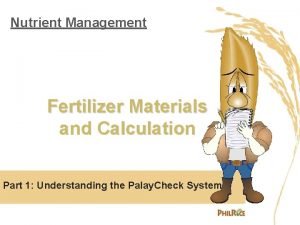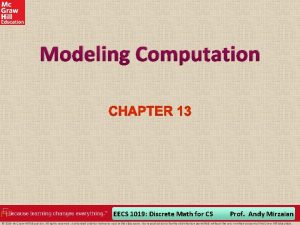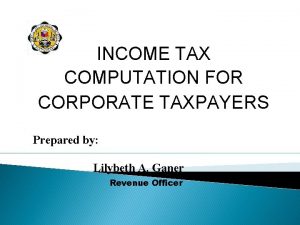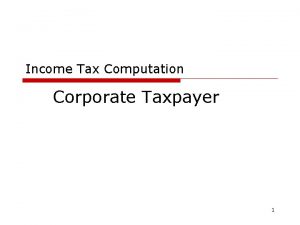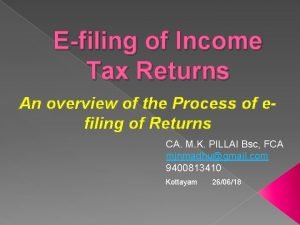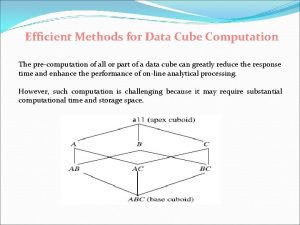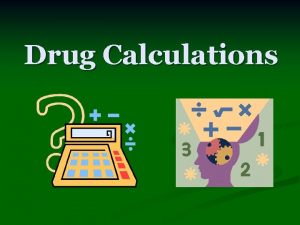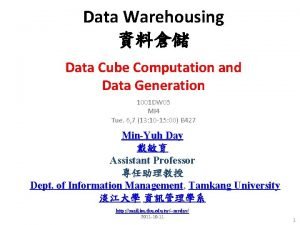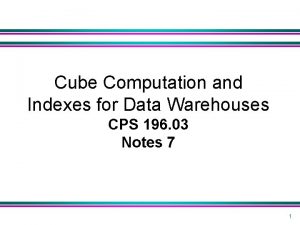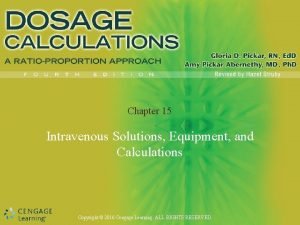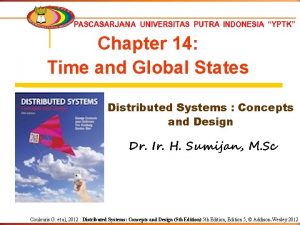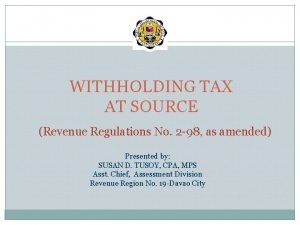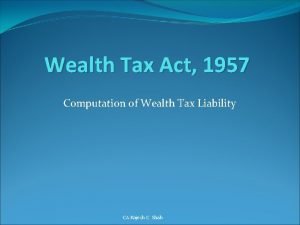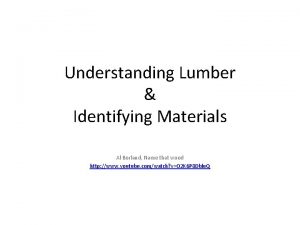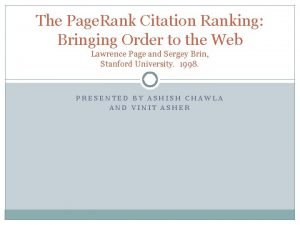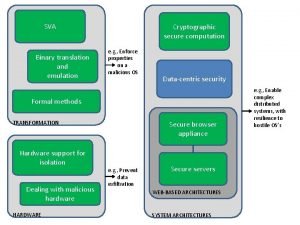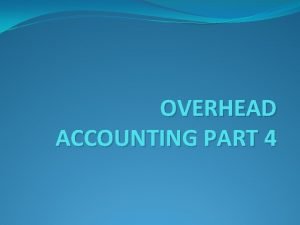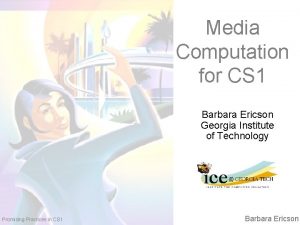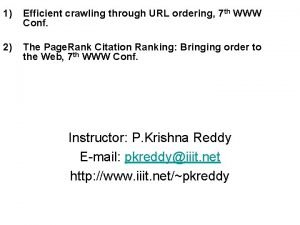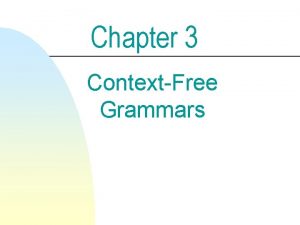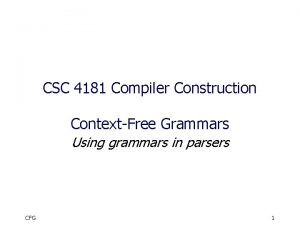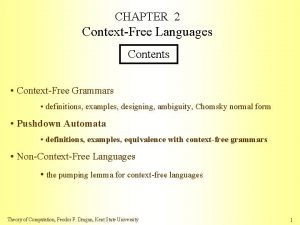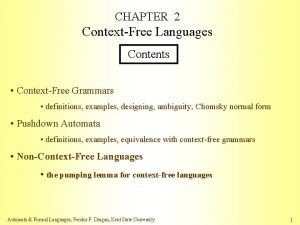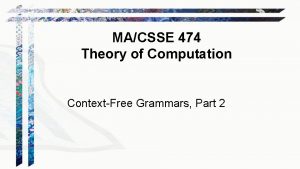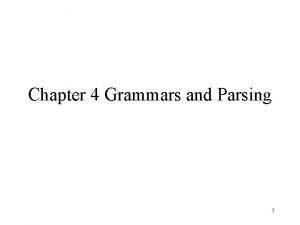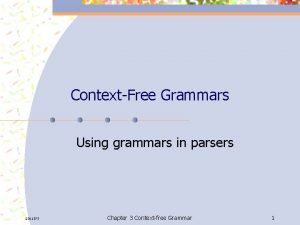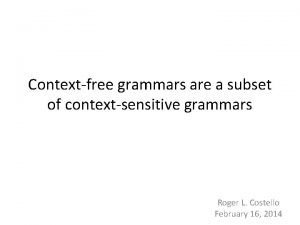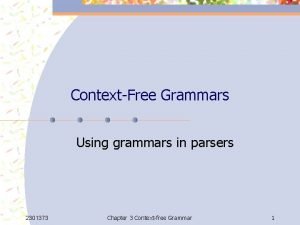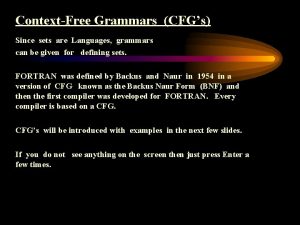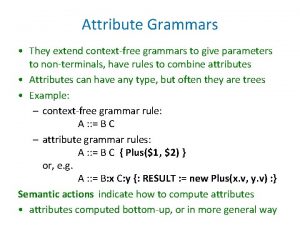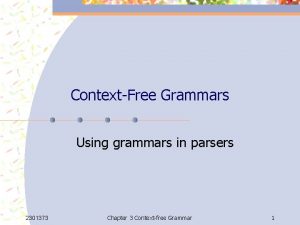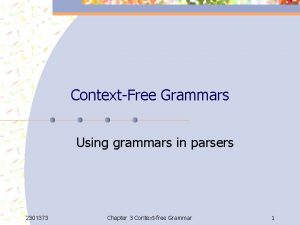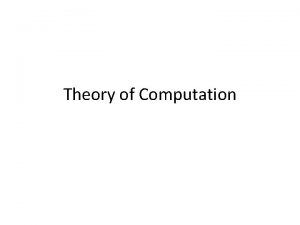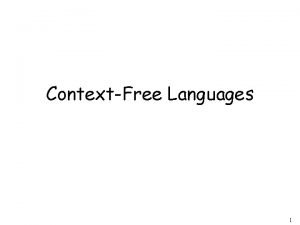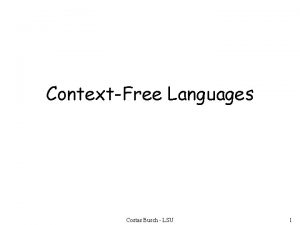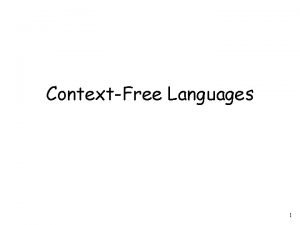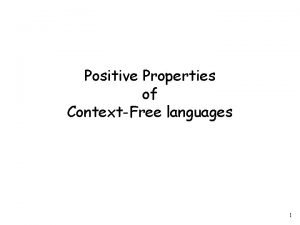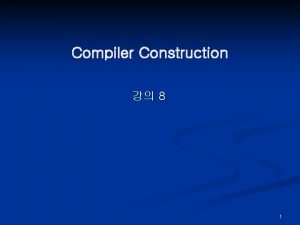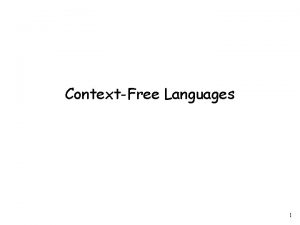CSC 4170CSC 8510 Theory of Computation ContextFree Grammars















































- Slides: 47

CSC 4170/CSC 8510 Theory of Computation Context-Free Grammars Chapter 2

2. 1. a What is a CFG Terminals: 0, 1 Variables: A, B Productions: Start variable: A Derivation: A B 0 A 1 0 B 1 00 A 11 0011 A B Parse tree: A B A B 0 A 1 0 A 1 B 0 A 1

2. 1. b Our grammar simplified A 0 A 1 A A 0 A 1 00 A 11 000 A 111 0000 A 1111 00001111 What language does this grammar produce?

2. 1. c 1 A more complex CFG S N’_V_N’ N’ N | N_who_V_N’ N men | women | children V like | hate | respect S N’_V_N’ N’_like_N’ N_like_N women_like_children S N’ N women _ V like _ N’ N children

2. 1. c 2 A more complex CFG S N’_V_N’ N’ N | N_who_V_N’ N men | women | children V like | hate | respect N’ N men _ V respect S _ N’ N women _ who _ V hate _ N’ N children

2. 1. d Formal definitions A context-free grammar is a 4 -tuple (V, , R, S), where 1. V is a finite set called the variables; 2. is a finite set, disjoint from V, called the terminals; 3. R is a finite set of rules, with each rule being a pair of a variable and a string of variables and terminals; 4. S is an element of V called the start variable. If u, v, and w are strings of variables and terminals and A w is a rule, we say that u. Av yields uwv, written u. Av uwv. x * y means that x=y, or x y, or there are z 1, …, zn such that x z 1 … zn y. The language produced (defined, described) by the grammar is {w | S * w and w is a string of (only) terminals}. A context-free language is a language produced by some CFG.

2. 1. e Ambiguity: An informal example the girl touches the boy with the flower Does this mean the girl touches (the boy with the flower) the girl or touches the boy with the flower (the girl touches the boy) with the flower ? the girl touches the boy

2. 1. f An example of an ambiguous CFG <EXPR> + <EXPR> | a a+a a <EXPR> + a <EXPR> <EXPR> a a + <EXPR> a A grammar is ambiguous iff it has two different parse trees for the same string a

2. 1. g An equivalent but unambiguous grammar <EXPR> + <TERM> | <TERM> a | a <EXPR> <TERM> a + <TERM> a a+a a a

2. 1. h A more complex unambiguous grammar <EXPR> + <TERM> | <TERM> <FACTOR> | <FACTOR> (<EXPR>) | a <EXPR> <TERM> <EXPR> + <TERM> <FACTOR> a <FACTOR> <TERM> <FACTOR> a a+a a a ( a <EXPR> + ) <TERM> <FACTOR> a a (a + a) a

2. 1. i Designing context-free grammars Design a CFG that produces all regular expressions over the alphabet {0, 1}: <RE> Design a CFG G that produces the union of the languages produced by two given CFGs G 1 and G 2. G 1: A 1 w 1 … An wn G 2: B 1 u 1 … B m um

2. 1. j Converting a DFA into a CFG 0 0 Variables: The states of the DFA Q 1 1 1 Start variable: The start state of the DFA Productions: 1. Qi a Qj, whenever there is an a-arrow from Qi to Qj; 2. Qi , whenever Qi is an accept state. Q 2

2. 1. j Testing in work Q 1 01 Q 2 011 Q 1 01100 Q 1 011001 Q 2 011001 0 0 Q 1 Q 1 1 Q 2 0 Q 2 1 Q 2 Q 1 011001 1 1 Q 2

2. 2 Giorgi Japaridze Theory of Computability Pushdown automata Just as to regular languages correspond finite automata, to context-free languages correspond pushdown automata. This is a new model of computation. What makes a PDA different from NFA is that it has potentially infinite, stack-type (LIFO) memory, where unlimited number of things can be remembered (pushed) and read (popped). A given transition depends on not only the current symbol in the input, but also the symbol currently at the top of the stack. PDAs are still not the most powerful machines. This is because of their limited (LIFO) access to memory.

2. 2. a Components of a pushdown automaton (PDA) x y x z Stack Input a a b a c … Push: write a symbol on the top of the stack Pop: delete a symbol from the top of the stack . . . (Q, , s, F) Q is the set of states is the input alphabet is the stack alphabet is the transition function s is the start state F Q is the set of accept states q 1 a, x y q 2 If the input symbol is a and the top stack symbol is x, go from q 1 to q 2, pop x and push y If a= , the read head is not advanced If x= , nothing is popped If y= , nothing is pushed

2. 2. b 1 How a PDA works q 1 , $ 0, 0 q 2 1, 0 q 4 , $ q 3 1, 0 0 1 1 1 Stack Input

2. 2. b 2 How a PDA works q 1 , $ 0, 0 q 2 1, 0 q 4 , $ q 3 1, 0 $ 0 0 0 1 1 1 Stack Input

2. 2. b 3 How a PDA works q 1 , $ 0, 0 q 2 1, 0 q 4 , $ q 3 1, 0 0 $ 0 0 0 1 1 1 Stack Input

2. 2. b 4 How a PDA works q 1 , $ 0, 0 q 2 1, 0 q 4 , $ q 3 1, 0 0 0 $ 0 0 0 1 1 1 Stack Input

2. 2. b 5 How a PDA works q 1 , $ 0, 0 q 2 1, 0 q 4 , $ q 3 1, 0 0 $ 0 0 0 1 1 1 Stack Input

2. 2. b 6 How a PDA works q 1 , $ 0, 0 q 2 1, 0 q 4 , $ q 3 1, 0 0 0 $ 0 0 0 1 1 1 Stack Input

2. 2. b 7 How a PDA works q 1 , $ 0, 0 q 2 1, 0 q 4 , $ q 3 1, 0 0 $ 0 0 0 1 1 1 Stack Input

2. 2. b 8 How a PDA works q 1 , $ 0, 0 q 2 1, 0 q 4 , $ q 3 1, 0 $ 0 0 0 1 1 1 Stack Input

2. 2. b 9 How a PDA works q 1 , $ 0, 0 q 2 1, 0 q 4 , $ q 3 1, 0 Accept 0 0 0 1 1 1 Stack Input

2. 2. b 10 How a PDA works q 1 , $ q 2 0, 0 1, 0 q 4 , $ q 3 1, 0 What language does this automaton recognize?

2. 2. b 11 How a PDA works q 1 , $ 0, 0 q 2 1, 0 q 4 , $ q 3 1, 0 0 0 1 Stack Input

2. 2. b 12 How a PDA works q 1 , $ 0, 0 q 2 1, 0 q 4 $ Stack , $ q 3 1, 0 0 0 1 Input

2. 2. b 13 How a PDA works q 1 , $ 0, 0 q 2 1, 0 q 4 0 $ Stack , $ q 3 1, 0 0 0 1 Input

2. 2. b 14 How a PDA works q 1 , $ 0, 0 q 2 1, 0 q 4 0 0 $ Stack , $ q 3 1, 0 0 0 1 Input

2. 2. b 15 How a PDA works q 1 , $ 0, 0 q 2 1, 0 q 4 , $ q 3 1, 0 Reject 0 $ Stack 0 0 1 Input

2. 2. b 16 How a PDA works q 1 , $ 0, 0 q 2 1, 0 q 4 , $ q 3 1, 0 0 1 1 Stack Input

2. 2. b 17 How a PDA works q 1 , $ 0, 0 q 2 1, 0 q 4 $ Stack , $ q 3 1, 0 0 1 1 Input

Giorgi Japaridze Theory of Computability 2. 2. b 18 How a PDA works q 1 , $ 0, 0 q 2 1, 0 q 4 0 $ Stack , $ q 3 1, 0 0 1 1 Input

Giorgi Japaridze Theory of Computability 2. 2. b 19 How a PDA works q 1 , $ 0, 0 q 2 1, 0 q 4 $ Stack , $ q 3 1, 0 0 1 1 Input

Giorgi Japaridze Theory of Computability 2. 2. b 20 How a PDA works q 1 , $ 0, 0 q 2 1, 0 q 4 , $ q 3 1, 0 Reject 0 1 1 Stack Input

Giorgi Japaridze Theory of Computability 2. 2. b 21 How a PDA works q 1 , $ 0, 0 q 2 1, 0 q 4 , $ q 3 1, 0 0 1 0 Stack Input

Giorgi Japaridze Theory of Computability 2. 2. b 22 How a PDA works q 1 , $ 0, 0 q 2 1, 0 q 4 $ Stack , $ q 3 1, 0 0 1 0 Input

Giorgi Japaridze Theory of Computability 2. 2. b 23 How a PDA works q 1 , $ 0, 0 q 2 1, 0 q 4 0 $ Stack , $ q 3 1, 0 0 1 0 Input

Giorgi Japaridze Theory of Computability 2. 2. b 24 How a PDA works q 1 , $ 0, 0 q 2 1, 0 q 4 $ Stack , $ q 3 1, 0 0 1 0 Input

Giorgi Japaridze Theory of Computability 2. 2. b 25 How a PDA works q 1 , $ 0, 0 q 2 1, 0 q 4 , $ q 3 1, 0 Reject 0 1 0 Stack Input

Giorgi Japaridze Theory of Computability 2. 2. c Designing pushdown automata Design a pushdown automaton that recognizes the language {w | w has an equal number of 0 s and 1 s} 0 s = 1

Giorgi Japaridze Theory of Computability 2. 2. d Converting NFA into PDA Every NFA can be understood as a PDA that never pushes or pops. Just replace every label a of the NFA by a, 1 1 b a , a, b, a 3 a b 2 a, 3 a, b, 2

2. 2. e Giorgi Japaridze Theory of Computability Main theorems Theorem 2. 20: A language is context-free iff some pushdown automaton recognizes it. Theorem: Not every nondeterministic PDA has an equivalent deterministic PDA. Example 2. 18: There is a nondeterministic PDA recognizing {ww. R | w {0, 1}* } (w. R means w reversed), but no deterministic PDA can recognize this language. Proofs omitted.

2. 3. a Giorgi Japaridze Theory of Computability The pumping lemma for context-free languages Theorem 2. 34 (Pumping lemma for context-free languages) If L is a context-free language, then there is a number p (the pumping length) where, if s is any string in L of length at least p, then s may be divided into five pieces s = uvxyz satisfying the conditions: 1. For each i 0, uvixyiz L; 2. |vy| > 0; 3. |vxy| p. uxz uvxyz uvvxyyz uvvvxyyyz uvvvvxyyyyz uvvvvvxyyyyyz

2. 3. b Giorgi Japaridze Theory of Computability The pumping lemma in work: example S “R” is a regular expression R 0 | ( R )* “ 0” is a regular expression “(0)*” is a regular expression “((0)*)*” is a regular expression “(((0)*)*)*” is a regular expression … “((0)*)*” is a regular expression uv 0 xy 0 z: uv 1 xy 1 z: uv 2 xy 2 z: uv 3 xy 3 z: u = “( v=( x=0 y = )* z = )*” is a regular expression “(0)*” is a regular expression “((0)*)*” is a regular expression “(((0)*)*)*” is a regular expression “((((0)*)*” is a regular expression

2. 3. c Giorgi Japaridze Theory of Computability Using the pumping lemma for proving that certain languages are not CF Example 2. 36: Show that the following language is not CF: B = {anbncn | n 0} Proof by contradiction: Assume B is CF. Let then p be its pumping length. Select w B with |w| p. By the pumping lemma, w=uvxyz and v and y can be pumped. If either v or y contain more than one type of symbols, then pumping would intermix these symbols in a wrong way. aaaabbbbcccc B aaaababbbbccccc B Thus, one of the three symbols should be neither in neither v, nor in y. aaaabbbbcccc B But then, after pumping, the number of that symbol will not change, while the number of the other symbols will increase. aaaaaabbbbcccc B

2. 3. d Giorgi Japaridze Theory of Computability Regular vs context-free vs computer-recognizable languages Context-free languages Regular languages {anbn | n 0} {anbncn | n 0}
 Unrestricted grammars
Unrestricted grammars Handling questions in context-free grammars
Handling questions in context-free grammars Regular grammars generate regular languages
Regular grammars generate regular languages Remove epsilon productions
Remove epsilon productions Unrestricted grammar
Unrestricted grammar Sipser, m: introduction to the theory of computation
Sipser, m: introduction to the theory of computation Theory of computation
Theory of computation Define transition graph
Define transition graph Types of languages in theory of computation
Types of languages in theory of computation Theory of computation
Theory of computation Theory of computation
Theory of computation Theory of computation
Theory of computation Is etm recognizable
Is etm recognizable Time hierarchy theorem proof
Time hierarchy theorem proof Pda
Pda Theory of computation quiz
Theory of computation quiz Computation
Computation Dfa to nfa
Dfa to nfa The theory of computation
The theory of computation Theory of computation
Theory of computation Tax due formula
Tax due formula Expanded withholding tax computation
Expanded withholding tax computation Expanded withholding tax computation
Expanded withholding tax computation Bir form 1901 job order
Bir form 1901 job order Fertilizer computation examples
Fertilizer computation examples Modeling computation discrete math
Modeling computation discrete math Mcit computation example
Mcit computation example Income tax computation format
Income tax computation format Crystalloid fluids examples
Crystalloid fluids examples Income tax computation format
Income tax computation format Efficient methods for data cube computation
Efficient methods for data cube computation Drug computation
Drug computation Data cube computation
Data cube computation Data cube computation
Data cube computation Drop factor constant
Drop factor constant Cuts of a distributed computation
Cuts of a distributed computation Expanded withholding tax revenue regulation
Expanded withholding tax revenue regulation Net maintainable rent
Net maintainable rent Board feet calculator
Board feet calculator The pagerank citation ranking
The pagerank citation ranking Pagerank computation
Pagerank computation The pagerank citation ranking: bringing order to the web
The pagerank citation ranking: bringing order to the web Binary search in secure computation
Binary search in secure computation Reminder symbol
Reminder symbol Computation of machine hour rate
Computation of machine hour rate Media computation
Media computation Different types of errors in numerical methods
Different types of errors in numerical methods Pagerank computation
Pagerank computation

